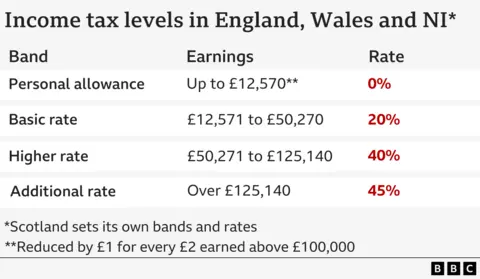Business
What are National Insurance and income tax and what could change in the Budget?

 Getty Images
Getty ImagesThere has been speculation that November’s Budget could see Chancellor Rachel Reeves break Labour’s pre-election pledge not to increase income tax, National Insurance (NI) or VAT for working people.
It’s been suggested that she could extend a freeze to the income thresholds at which people start paying the taxes, or have to pay more.
What is National Insurance and what does it pay for?
The government uses National Insurance to pay benefits and help fund the NHS.
It is paid by employees, employers and the self-employed across the UK. Those over the state pension age do not pay it, even if they are working.
Eligibility for some benefits, including the state pension, depends on the National Insurance contributions (NICs) you make across your working life. It may be possible to make voluntary payments to fill gaps in your contribution history.
How much do employees pay in National Insurance?
The type and amount of NI you pay depends on your age, employment status and income.
Workers start paying NI when they turn 16 and earn more than £242 a week, or have self-employed profits of more than £12,570 a year.
The amount owed is usually deducted automatically from employees’ wages along with income tax.
The starting rate for NI for employees fell twice in 2024: from 12% to 10%, and then again to 8%. The previous Conservative government said these cuts were worth about £900 a year for a worker earning £35,000.
For the self-employed, the rate of NI paid on all earnings between £12,570 and £50,270 fell from 9% to 6%. This was said to be worth £350 to a self-employed person earning £28,200.
Most self-employed people pay their NICs through their self assessment tax return.
The NI rate on income and profits above £50,270 is 2% for all workers.
How much do employers pay in National Insurance?
Since April 2025, employers pay NI at 15% on most employees’ wages above £5,000. They previously paid 13.8% on salaries above £9,100.
Businesses also pay 15% NI on expenses and benefits they give to their staff – such as company cars or health insurance.
The employment allowance – the amount employers can claim back from their NI bill – rose from £5,000 to £10,500.
What are the current income tax rates?
You have to pay income tax on your earnings from employment, or profits from self-employment, above the tax-free personal allowance of £12,570.
Income tax is also paid on some benefits and pensions, income from renting out property, and returns from savings and investments above certain limits.

The basic rate of 20% is paid on annual earnings between £12,571 and £50,270.
The higher rate of 40% is paid on earnings between £50,271 and £125,140.
Once you earn more than £100,000, you also start losing the £12,570 tax-free personal allowance. You lose £1 of your personal allowance for every £2 that your income goes above £100,000.
Anyone earning more than £125,140 a year no longer has any tax-free personal allowance.
They also pay an additional rate of income tax of 45% on all earnings above that amount.
These rates apply in England, Wales and Northern Ireland.
Some income tax rates are different in Scotland, where a new 45% band took effect in April 2024. At the same time the top rate also rose from 47% to 48%.
What are NI and income tax thresholds and why do they matter?
Changes to the income thresholds mean that millions are paying more tax overall, despite the 2024 NI cuts.
The thresholds are the income levels at which people start paying NI or income tax, or have to pay higher rates. These used to rise every year in line with inflation.
However, the previous Conservative government froze the NI threshold and tax-free personal allowance at £12,570 until 2028. It also kept the higher-rate tax threshold at £50,270.
Prime Minister Sir Keir Starmer and the chancellor have both refused to rule out extending the current freeze.
Freezing the thresholds means that more people start paying tax and NI as their wages increase, and more people pay higher rates.
According to the Institute for Fiscal Studies (IFS) think thank, the freeze cancelled out the benefits of the 2024 NI cuts for some workers.
In the 2024-25 tax year, it said an average earner would have a tax cut of about £340 – from the combined tax changes – and people earning between £26,000 and £60,000 would be better off.
But by 2027, it said the average earner would be only £140 better off – and only people earning between £32,000 and £55,000 a year would still benefit.
Business
Key Financial Deadlines That Have Been Extended For December 2025; Know The Last Date

New Delhi: Several crucial deadlines have been extended in December 2025, including ITR for tax audit cases, ITR filing and PAN and Aadhaar linking. These deadlines will be crucial in ensuring that your financial affairs operate smoothly in the months ahead.
Here is a quick rundown of the important deadlines for December to help you stay compliant and avoid last-minute hassles.
ITR deadline for tax audit cases
The Central Board of Direct Taxes has extended the due date of furnishing of return of income under sub-Section (1) of Section 139 of the Act for the Assessment Year 2025-26 which is October 31, 2025 in the case of assessees referred in clause (a) of Explanation 2 to sub-Section (1) of Section 139 of the Act, to December 10, 2025.
Belated ITR filing deadline
A belated ITR filing happens when an ITR is submitted after the original due date which is permitted by Section 139(4) of the Income Tax Act. Filing a belated return helps you meet your tax obligations, but it involves penalties. You can only file a belated return for FY 2024–25 until December 31, 2025. However, there will be a late fee and interest charged.
PAN and Aadhaar linking deadline
The Income Tax Department has extended the deadline to link their PAN with Aadhaar card to December 31, 2025 for anyone who acquired their PAN using an Aadhaar enrolment ID before October 1, 2024. If you miss this deadline your PAN will become inoperative which will have an impact on your banking transactions, income tax return filing and other financial investments.
Business
Stock Market Live Updates: Sensex, Nifty Hit Record Highs; Bank Nifty Climbs 60,000 For The First Time

Stock Market News Live Updates: Indian equity benchmarks opened with a strong gap-up on Monday, December 1, touching fresh record highs, buoyed by a sharp acceleration in Q2FY26 GDP growth to a six-quarter peak of 8.2%. Positive cues from Asian markets further lifted investor sentiment.
The BSE Sensex was trading at 85,994, up 288 points or 0.34%, after touching an all-time high of 86,159 in early deals. The Nifty 50 stood at 26,290, higher by 87 points or 0.33%, after scaling a record intraday high of 26,325.8.
Broader markets also saw gains, with the Midcap index rising 0.27% and the Smallcap index advancing 0.52%.
On the sectoral front, the Nifty Bank hit a historic milestone by crossing the 60,000 mark for the first time, gaining 0.4% to touch a fresh peak of 60,114.05.
Meanwhile, the Metal and PSU Bank indices climbed 0.8% each in early trade.
Global cues
Asia-Pacific markets were mostly lower on Monday as traders assessed fresh Chinese manufacturing data and increasingly priced in the likelihood of a US Federal Reserve rate cut later this month.
According to the CME FedWatch Tool, markets are now assigning an 87.4 per cent probability to a rate cut at the Fed’s December 10 meeting.
China’s factory activity unexpectedly slipped back into contraction in November, with the RatingDog China General Manufacturing PMI by S&P Global easing to 49.9, below expectations of 50.5, as weak domestic demand persisted.
Japan’s Nikkei 225 slipped 1.6 per cent, while the broader Topix declined 0.86 per cent. In South Korea, the Kospi dropped 0.30 per cent and Australia’s S&P/ASX 200 was down 0.31 per cent.
US stock futures were steady in early Asian trade after a positive week on Wall Street. On Friday, in a shortened post-Thanksgiving session, the Nasdaq Composite climbed 0.65 per cent to 23,365.69, its fifth consecutive day of gains.
The S&P 500 rose 0.54 per cent to 6,849.09, while the Dow Jones Industrial Average added 289.30 points, or 0.61 per cent, to close at 47,716.42.
Business
Global Conflicts Drive Arms Industry to $679 Billion Record Revenues – SUCH TV

Sales by the world’s top 100 arms makers reached a record $679 billion last year, as conflicts in Ukraine and Gaza fueled demand, according to researchers. Production challenges, however, continued to hamper timely deliveries.
The figure represents a 5.9 percent increase from the previous year, and over the 2015–2024 period, revenues for the top 100 arms makers have grown by 26 percent, according to a report by the Stockholm International Peace Research Institute (SIPRI).
“Last year, global arms revenues reached the highest level ever recorded by SIPRI, as producers capitalized on strong demand,” said Lorenzo Scarazzato, a researcher with the SIPRI Military Expenditure and Arms Production Programme.
Regional Trends
According to SIPRI researcher Jade Guiberteau Ricard, the growth is mostly driven by Europe, though all regions saw increases except Asia and Oceania.
The surge in Europe is linked to the war in Ukraine and heightened security concerns regarding Russia.
Countries supporting Ukraine and replenishing their stockpiles have also contributed to rising demand.
Ricard added that many European nations are now seeking to modernize and expand their militaries, creating a new source of demand.
US and European Arms Makers
The United States hosts 39 of the world’s top 100 arms makers, including the top three: Lockheed Martin, RTX (formerly Raytheon Technologies), and Northrop Grumman. US companies saw combined revenues rise 3.8 percent to $334 billion, nearly half of the global total.
European arms makers (26 companies in the top 100) recorded aggregate revenues of $151 billion, a 13 percent increase.
The Czech company Czechoslovak Group recorded the sharpest rise, with revenues jumping 193 percent to $3.6 billion, benefiting from the Czech Ammunition Initiative, which supplies artillery shells to Ukraine.
However, European producers face challenges in meeting increased demand, as sourcing raw materials has become more difficult.
Companies like Airbus and France’s Safran previously sourced half of their titanium from Russia before 2022 and have had to identify new suppliers.
Additionally, Chinese export restrictions on critical minerals have forced firms such as France’s Thales and Germany’s Rheinmetall to restructure supply chains, raising costs.
Russian Arms Industry
Two Russian arms makers, Rostec and United Shipbuilding Corporation, are among the top 100, with combined revenues rising 23 percent to $31.2 billion, despite component shortages caused by international sanctions.
Domestic demand largely offset the decline in exports. However, Russia’s arms industry faces a shortage of skilled labor, limiting its ability to sustain production rates necessary for ongoing military operations.
Israeli weapons still popular
The Asia and Oceania region was the only region to see the overall revenues of the 23 companies based there go down — their combined revenues dropped 1.2 percent to $130 billion.
But the authors stressed that the picture across Asia was varied and the overall drop was the result of by a larger drop among Chinese arms makers.
“A host of corruption allegations in Chinese arms procurement led to major arms contracts being postponed or cancelled in 2024,” Nan Tian, Director of SIPRI’s Military Expenditure and Arms Production Programme, said in a statement.
Tian added that the drop deepened “uncertainty” around China’s efforts to modernise its military.
In contrast, Japanese and South Korean weapons makers saw their revenues increase, also driven by European demand.
Meanwhile, nine of the top 100 arms companies were based in the Middle East, with combined revenues of $31 billion.
The three Israeli arms companies in the ranking accounted for more than half of that, as their combined revenues grew by 16 percent to $16.2 billion.
SIPRI researcher Zubaida Karim noted in a statement that “the growing backlash over Israel’s actions in Gaza seems to have had little impact on interest in Israeli weapons”.
-

 Sports1 week ago
Sports1 week agoWATCH: Ronaldo scores spectacular bicycle kick
-

 Entertainment1 week ago
Entertainment1 week agoWelcome to Derry’ episode 5 delivers shocking twist
-

 Politics1 week ago
Politics1 week agoWashington and Kyiv Stress Any Peace Deal Must Fully Respect Ukraine’s Sovereignty
-

 Business1 week ago
Business1 week agoKey economic data and trends that will shape Rachel Reeves’ Budget
-

 Tech6 days ago
Tech6 days agoWake Up—the Best Black Friday Mattress Sales Are Here
-

 Politics1 week ago
Politics1 week ago53,000 Sikhs vote in Ottawa Khalistan Referendum amid Carney-Modi trade talks scrutiny
-

 Fashion1 week ago
Fashion1 week agoCanada’s Lululemon unveils team Canada kit for Milano Cortina 2026
-

 Tech6 days ago
Tech6 days agoThe Alienware Aurora Gaming Desktop Punches Above Its Weight







